Custom virtual machine installation
1, Create a virtual switch
Principle: call dnsmasq to provide DNS, DHCP and other functions
Create configuration file / etc/libvirt/qemu/networks/vbr.xml
<network>
<name>vbr</name>
<bridge name="vbr"/>
<forward mode="nat"/>
<ip address="192.168.1.254" netmask="255.255.255.0">
<dhcp>
<range start="192.168.1.100" end="192.168.1.200"/>
</dhcp>
</ip>
</network>
2, Quick configuration of network yum source on real room
[root@room ~]# yum install vsftp [root@room ~]# vim /etc/vsftpd/vsftpd.conf ... listen=YES listen_ipv6=NO ... [root@room ~]# systemctl enable vsftpd [root@room ~]# systemctl start vsftpd [root@room ~]# mkdir /var/ftp/centos7 [root@room ~]# mount –t iso9660 –o loop,ro /root/CentOS7-1708.iso /var/ftp/centos7 [root@room ~]# yum repolist
3, Graphical installation of virtual machine by virt Manager
1. Start the virt manager software and select new virtual machine
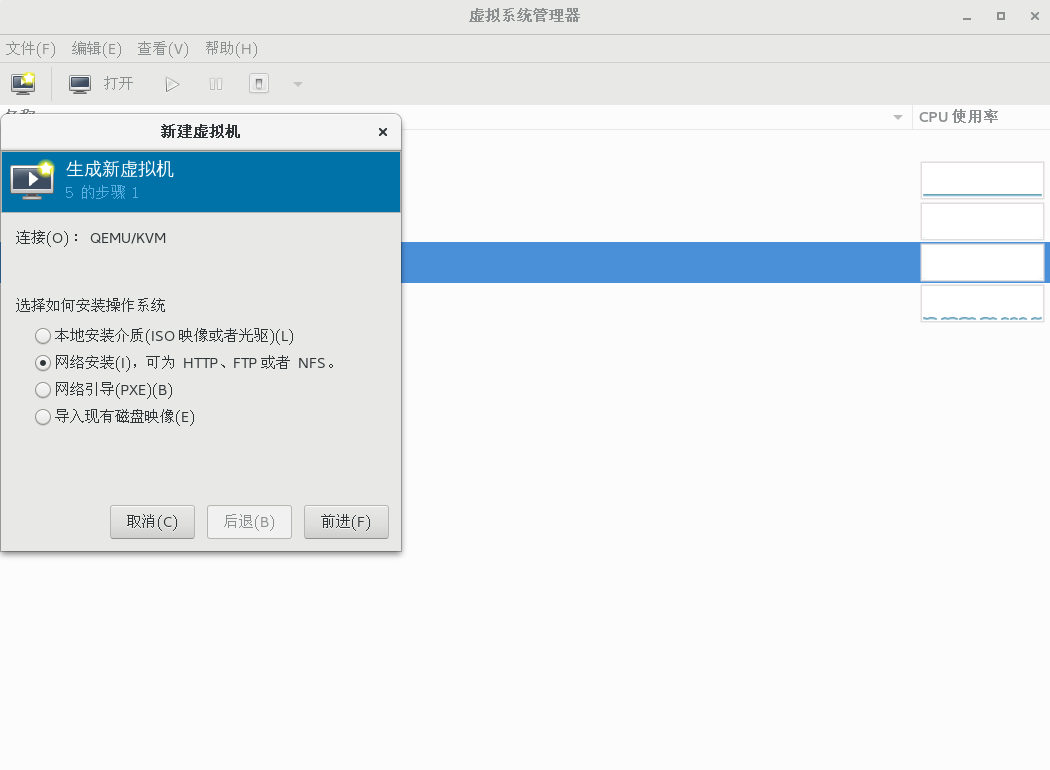 2. Select network installation source
2. Select network installation source
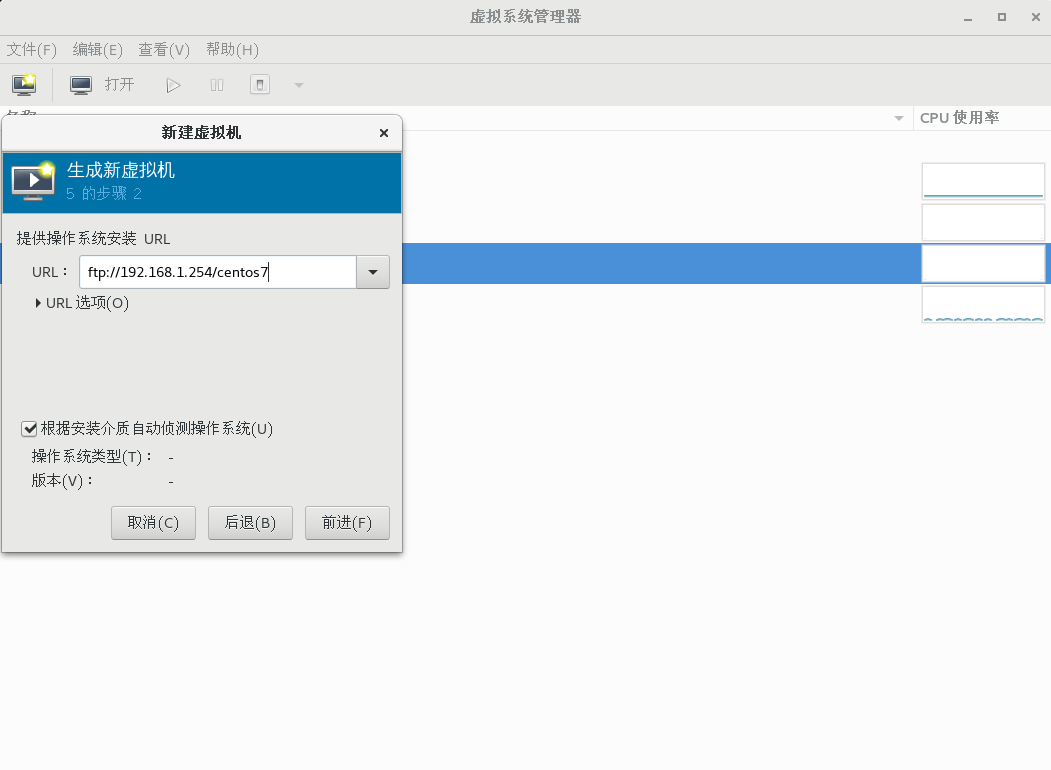 3. Create a custom image file node.img
3. Create a custom image file node.img
[root@room ~]# qemu-img create -f qcow2 /var/lib/libvirt/images/node.img 16G

4. vbr for network selection
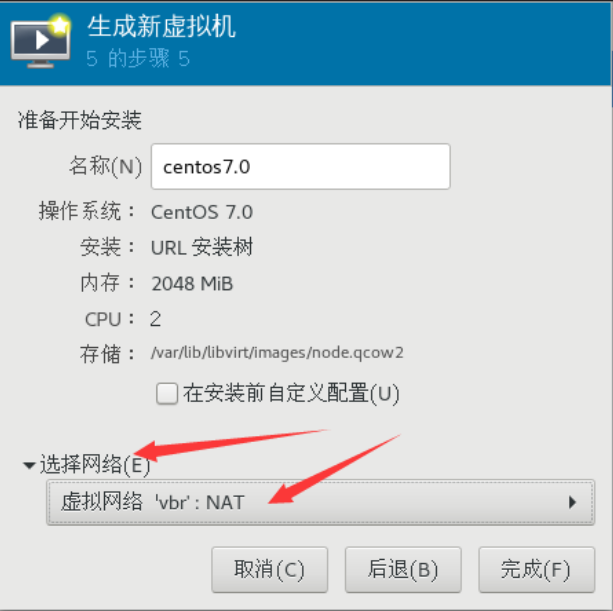
5. Select minimal, close KDUMP, and select Manual partition
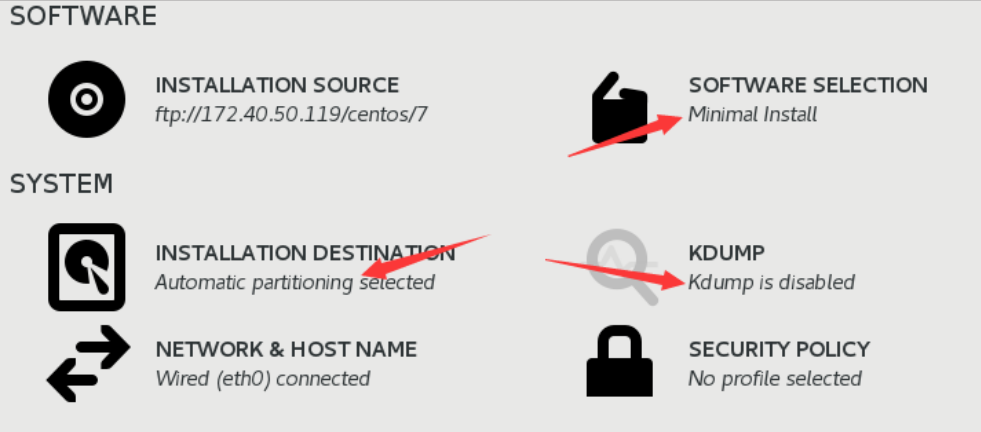
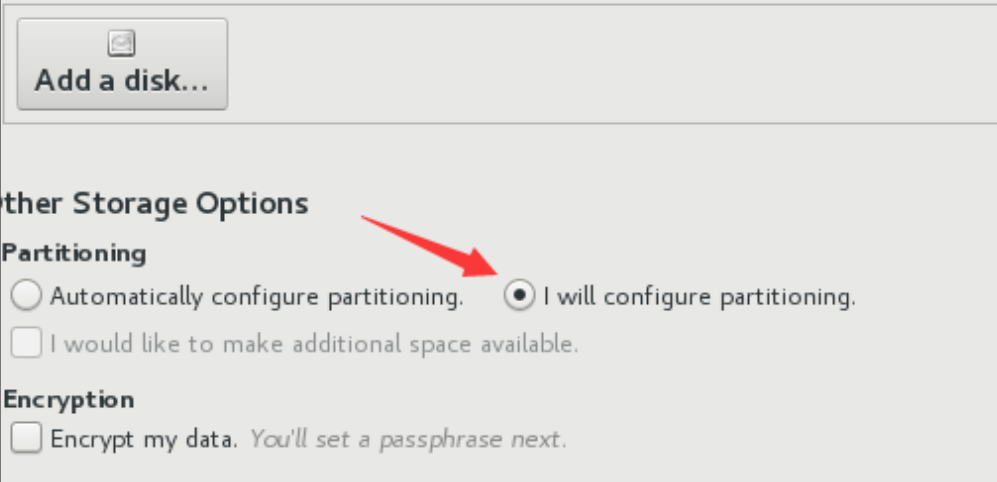
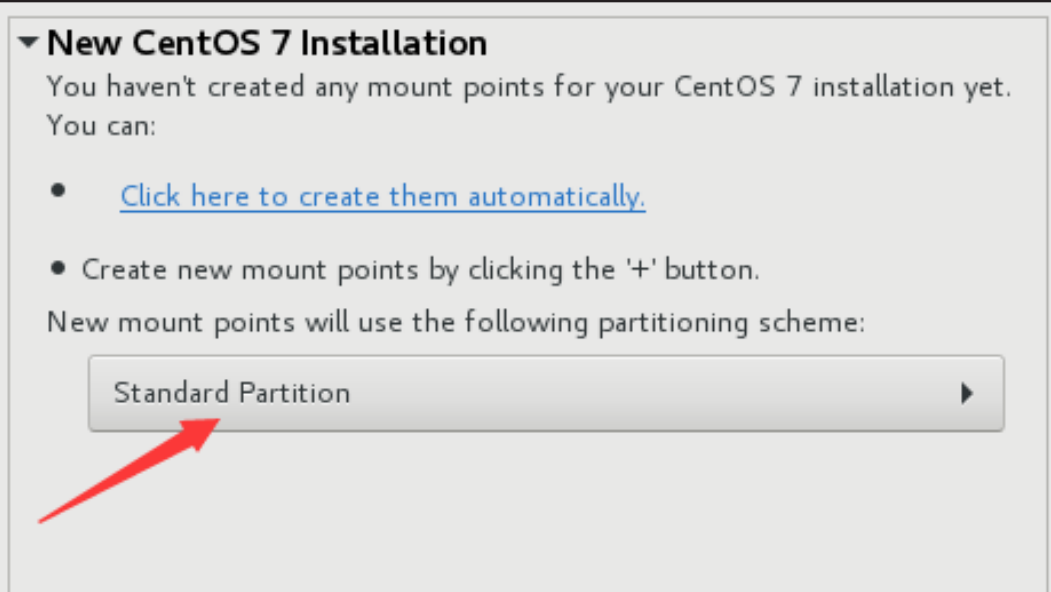
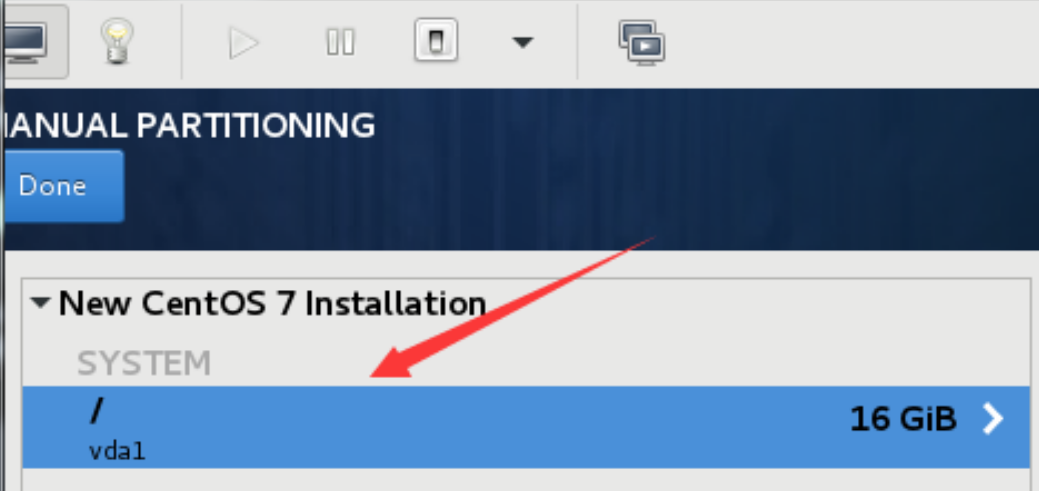
4, Virtual machine template making
Initialize the newly installed system
1. Disable selinux
[root@localhost ~]# vim /etc/selinux/config SELINUX=disabled
2. Uninstall related software
[root@localhost ~]# yum remove -y NetworkManager-* firewalld-*
3. Configure yum source
[root@localhost ~]# vim /etc/yum.repo.d/centos7.repo [local_repo] name=centos7 baseurl="ftp://192.168.1.254/centos7" enabled=1 gpgcheck=0
4. Common system command installation
[root@localhost ~]# yum install -y net-tools vim-enhanced bridge-utils
5. Modify the network card configuration file
[root@localhost ~]# vim /etc/sysconfig/network-scripts/ifcfg-eth0 DEVICE="eth0" ONBOOT="yes" IPV6INIT="no" TYPE="Ethernet" BOOTPROTO ="dhcp"
6. Disable empty routing
[root@localhost ~]# vim /etc/sysconfig/network NOZEROCONF="yes"
7. Restart the machine
[root@localhost ~]# reboot
8. Add the Console configuration and personalized information in the initial partition removal
[root@localhost ~]# vim /etc/default/grub ... GRUB_CMDLINE_LINUX="biosdevname=0 net.ifnames=0 console=ttyS0,115200n8" GRUB_DISABLE_LINUX_UUID="true" GRUB_ENABLE_LINUX_LABEL="true"
9. Regenerate grub.cfg
[root@localhost ~]# grub2-mkconfig -o /boot/grub2/grub.cfg
10. Modify / etc/fstab, blkid to view the disk device corresponding to UUID, and modify UUID to system device
[root@localhost ~]# blkid /dev/vda1: UUID="98bd48a3-dd66-49bd-a0e1-3c70e337f2aa" TYPE="xfs" [root@localhost ~]# vim /etc/fstab /dev/vda1 / xfs defaults 0 0
11. Install partition expansion software
[root@localhost ~]# yum install -y cloud-utils-growpart [root@localhost ~]# chmod 755 /etc/rc.local # Set the root directory of the first boot self expansion [root@localhost ~]# vim /etc/rc.local /usr/bin/growpart /dev/vda 1 # Expand partition space (make / dev/vda1 larger) /usr/sbin/xfs_growfs / # Expand file system identification space (make df-h usable space larger)
12. Shut down the virtual machine and clean up the information (real machine)
[root@room ~]# virt-sysprep -d centos7.0 [ 0.0] Examining the guest ... [ 28.9] Performing "abrt-data" ... [ 28.9] Performing "backup-files" ... [ 29.2] Performing "bash-history" ... [ 29.2] Performing "blkid-tab" ... [ 29.3] Performing "crash-data" ... [ 29.3] Performing "cron-spool" ... [ 29.3] Performing "dhcp-client-state" ... [ 29.3] Performing "dhcp-server-state" ... [ 29.3] Performing "dovecot-data" ... [ 29.3] Performing "logfile s" ... [ 29.3] Performing "machine-id" ... [ 29.3] Performing "mail-spool" ... [ 29.3] Performing "net-hostname" ... [ 29.3] Performing "net-hwaddr" ... [ 29.3] Performing "pacct-log" ... [ 29.3] Performing "package-manager-cache" ... [ 29.3] Performing "pam-data" ... [ 29.3] Performing "passwd-backups" ... [ 29.3] Performing "puppet-data-log" ... [ 29.3] Performing "rh-subscription-manager" ... [ 29.3] Performing "rhn-systemid" ... [ 29.3] Performing "rpm-db" ... [ 29.3] Performing "samba-db-log" ... [ 29.3] Performing "script" ... [ 29.3] Performing "smolt-uuid" ... [ 29.3] Performing "ssh-hostkeys" ... [ 29.3] Performing "ssh-userdir" ... [ 29.3] Performing "sssd-db-log" ... [ 29.3] Performing "tmp-files" ... [ 29.3] Performing "udev-persistent-net" ... [ 29.3] Performing "utmp" ... [ 29.3] Performing "yum-uuid" ... [ 29.3] Performing "customize" ... [ 29.3] Setting a random seed [ 29.8] Performing "lvm-uuids" ...
13. Backup XML configuration file of virtual machine
[root@room ~]#cd /etc/libvirt/qemu/ [root@room qemu]#cp centos7.xml centos7.0.xml.bak
14. Modify the XML configuration file as follows
<domain type='kvm'>
<name>node</name>
<memory unit='KB'>2097152</memory>
<currentMemory unit='KB'>2097152</currentMemory>
<vcpu placement='static'>2</vcpu>
<os>
<type arch='x86_64' machine='pc'>hvm</type>
<boot dev='hd'/>
<bootmenu enable='yes'/>
<bios useserial='yes'/>
</os>
<features>
<acpi/>
<apic/>
</features>
<cpu mode='host-passthrough'>
</cpu>
<clock offset='localtime'/>
<on_poweroff>destroy</on_poweroff>
<on_reboot>restart</on_reboot>
<on_crash>restart</on_crash>
<devices>
<emulator>/usr/libexec/qemu-kvm</emulator>
<disk type='file' device='disk'>
<driver name='qemu' type='qcow2'/>
<source file='/var/lib/libvirt/images/node.img'/>
<target dev='vda' bus='virtio'/>
</disk>
<interface type='bridge'>
<source bridge='vbr'/>
<model type='virtio'/>
</interface>
<channel type='unix'>
<target type='virtio' name='org.qemu.guest_agent.0'/>
</channel>
<serial type='pty'></serial>
<console type='pty'>
<target type='serial'/>
</console>
<memballoon model='virtio'></memballoon>
</devices>
</domain>
15. Delete virtual machine definition
[root@room ~]# virsh undefine centos7.0
16. View template virtual machine image
[root@room ~]# ll -h /var/lib/libvirt/images/node.img -rw-r--r-- 1 root root 1.2G 9 Month 717:35 node.img
5, Create virtual machine quickly - for example, create virtual machine node1
1. Create disk file
[root@room ~]# cd /var/lib/libvirt/images [root@room images]# qemu-img create -b node.img -f qcow2 node1.img 32G
2. Create virtual machine configuration file
[root@room images]#sed 's/node/node1/' /root/nsd1804/centos7.0.xml > /etc/libvirt/qemu/node1.xml [root@room images]#virsh define /etc/libvirt/qemu/node1.xml //Define domain node1 (from / etc/libvirt/qemu/node1.xml)
3. Start the virtual machine
[root@room images]#virsh start node1 Domain node1 started
4. Connect to view virtual machine
[root@room images]# virsh console node1